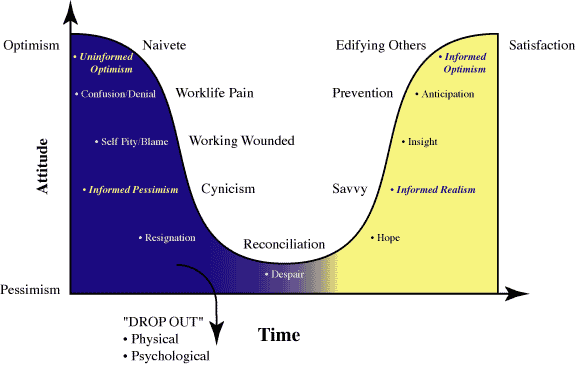Worklife Cycle of Adversity Model
Brigham Young University professor J. Bonner Ritchie’s work on issues of organizational abuse provides powerful imagery for dealing with the adversity we encounter in today’s workplaces:
Picture a U-shaped curve. We begin at the top naive, trusting, pristine. Bureaucratic entanglements may disenchant, frustrate, aggravate, and lead us to believe that there is a malevolent force operating in this organization which wants to destroy us, to get us; we become paranoid. Or, we have a little learning, a little knowledge, a little truth—enough to want control but not enough to understand the dangers of control, enough to victimize but not enough to liberate. We are then sloshing at the bottom of the curve. And that is the worst place to be. It takes tremendous self-discipline to kick out of the trough of the curve and to rise beyond . . . . We have a complex, cynical organizational society with a lot of people sloshing about in the bottom of the trough of bureaucratic encounters. We can no longer remain naive. We are all involved with organizations to such an extent that it is critical that we understand them. But to rise above the trough takes study, patience, understanding, struggle, fighting, learning, praying, thinking, reading, talking, acting. Unfortunately, many people spend their entire careers floundering at the bottom of the curve. They don’t know how to get out. To rise above the trough, most employees must rely upon their intuitive gut skill. Others use the behavioral sciences to manipulate outcomes favorable to themselves. Customarily seasoned by the rigors of working by the seat of our pants, we often end up burned out, cynical, or indifferent; our personal and organizational effectiveness is diminished.
To understand the relationships among time, attitude, and expectations
during the various stages of the healing journey of adversity at work,
we may extend Professor Ritchie's analogy to a U-shaped curve as the following:

One thing we know from the great heroes of all time, “The black moment is the moment when the real transformation is going to come. At the darkest moment comes the light.” As you can see from the chart, over time attitudes typically get worse before they get better, going through natural and progressive stages of the hero’s journey. The temptation is to drop out, by either physically leaving the job or by dropping out psychologically. We manufacture numerous distractions to keep us from confronting the very issues that will move us to higher ground, but, instead, keep us enslaved in our misery. But the only way out is through. By our visualizing the phases involved, and doing the work that needs to be done, our personal experiences begin to make sense, to become valid and congruent. We can anticipate what’s next, see where we might be stuck, and begin to unravel the complexity of these dynamic processes. We begin to realize there is more to the story than we understand, more to each of us than we remember. We can visualize coming out of difficult experiences wiser and more able to anticipate and prevent organizational pain in the future if we stick with the journey.
Download
the Free Book:
Heroworks: Becoming Your Own Hero at Work
Terms of use, privacy policy